Euphorbia: from Wikipedia
Euphorbia is a genus of plants belonging to the familyEuphorbiaceae. Consisting of 2008 species,[1]Euphorbia is one of the most diverse genera in the plant kingdom, exceeded possibly only by Senecio.[citation needed] Members of the family and genus are sometimes referred to as Spurges. Euphorbia antiquorum is the type species for the genus Euphorbia;[2] it was described by Carl Linnaeus in 1753 in Species Plantarum. The genus is primarily found in the tropical and subtropical regions of Africa and the Americas, but also in temperate zones worldwide. Succulent species originate mostly from Africa, the Americas and Madagascar. There exists a wide range of insular species: on the Hawaiian Islands where spurges are collectively known as "akoko",[3] and on the Canary Islands as "tabaibas".[4][5]
The common name "spurge" derives from the Middle English/Old Frenchespurge ("to purge"), due to the use of the plant's sap as a purgative.
The botanical nameEuphorbia derives from Euphorbus, the Greekphysician of king Juba II of Numidia (52–50 BC – 23 AD), who married the daughter of Anthony and Cleopatra.[6] He wrote that one of the cactus-like Euphorbias was a powerful laxative.[6] In 12 B.C., Juba named this plant after his physician Euphorbus in response to Augustus Ceasar dedicating a statue to Antonius Busa, his own personal physician.[6] Botanist and taxonomist Carl Linnaeus assigned the name Euphorbia to the entire genus in the physician's honor.[7]
Juba II himself was a noted patron of the arts and sciences and sponsored several expeditions and biological research. He also was a notable author, writing several scholarly and popular scientific works such as treatises on natural history or a best-selling traveller's guide to Arabia. Euphorbia regisjubae (King Juba's Euphorbia) was named to honor the king's contributions to natural history and his role in bringing the genus to notice.
Description The plants are annual or perennialherbs, woody shrubs or trees with a caustic, poisonous milky sap (latex). The roots are fine or thick and fleshy or tuberous. Many species are more or less succulent, thorny or unarmed. The main stem and mostly also the side arms of the succulent species are thick and fleshy, 15–91 cm (6–36 inches) tall. The deciduous leaves are opposite, alternate or in whorls. In succulent species the leaves are mostly small and short-lived. The stipules are mostly small, partly transformed into spines or glands, or missing.
Like all members of the family Euphorbiaceae, all spurges have unisexual flowers. In Euphorbia these are greatly reduced and grouped into pseudanthia called cyathia. The majority of species are monoecious (bearing male and female flowers on the same plant), although some are dioecious with male and female flowers occurring on different plants. It is not unusual for the central cyathia of a cyme to be purely male, and for lateral cyathia to carry both sexes. Sometimes young plants or those growing under unfavorable conditions are male only, and only produce female flowers in the cyathia with maturity or as growing conditions improve. The bracts are often leaf-like, sometimes brightly coloured and attractive, sometimes reduced to tiny scales. The fruits are three (rarely two) compartment capsules, sometimes fleshy but almost always ripening to a woody container that then splits open (explosively, see explosive dehiscence). The seeds are 4-angled, oval or spherical, and in some species have a caruncle.
[edit] Xerophytes and succulents In the genus Euphorbia, succulence in the species has often evolved divergently and to differing degrees. Sometimes it is difficult to decide, and it is a question of interpretation, whether or not a species is really succulent or "only" xerophytic. In some cases, especially with geophytes, plants closely related to the succulents are normal herbs. About 850 species are succulent in the strictest sense. If one includes slightly succulent and xerophytic species, this figure rises to about 1000, representing about 45% of all Euphorbia species.
[edit] Toxicity The latex (milky sap) of spurges acts as a deterrent for herbivores. Usually it is white, drying colourless, but in rare cases (e.g. E. abdelkuri) yellow. As it is under pressure, it runs out from the slightest wound and congeals within a few minutes of contact with the air. Among the component parts are many diterpene or triterpeneesters, which can vary in composition according to species, and in some cases the variant may be typical of that species. The terpene ester composition determines how caustic and irritating to the skin it is. In contact with mucous membranes (eyes, nose, mouth) the latex can produce extremely painful inflammation. In experiments with animals it was found that the terpene ester resiniferatoxin had an irritating effect 10,000 to 100,000 times stronger than capsaicin, the "hot" substance found in chili peppers. Several terpene esters are also known to be carcinogenic.[citation needed]
Therefore spurges should be handled with caution. Latex coming in contact with the skin should be washed off immediately and thoroughly. Partially or completely congealed latex is often no longer soluble in water, but can be removed with an emulsion (milk, hand-cream). A physician should be consulted regarding any inflammation of a mucous membrane, especially the eyes, as severe eye damage including possible permanent blindness may result from acute exposure to the sap.[8] It has been noticed, when cutting large succulent spurges in a greenhouse, that vapours from the latex spread and can cause severe irritation to the eyes and air passages several metres away. Precautions, including sufficient
Euphorbia Link
The common name "spurge" derives from the Middle English/Old Frenchespurge ("to purge"), due to the use of the plant's sap as a purgative.
The botanical nameEuphorbia derives from Euphorbus, the Greekphysician of king Juba II of Numidia (52–50 BC – 23 AD), who married the daughter of Anthony and Cleopatra.[6] He wrote that one of the cactus-like Euphorbias was a powerful laxative.[6] In 12 B.C., Juba named this plant after his physician Euphorbus in response to Augustus Ceasar dedicating a statue to Antonius Busa, his own personal physician.[6] Botanist and taxonomist Carl Linnaeus assigned the name Euphorbia to the entire genus in the physician's honor.[7]
Juba II himself was a noted patron of the arts and sciences and sponsored several expeditions and biological research. He also was a notable author, writing several scholarly and popular scientific works such as treatises on natural history or a best-selling traveller's guide to Arabia. Euphorbia regisjubae (King Juba's Euphorbia) was named to honor the king's contributions to natural history and his role in bringing the genus to notice.
Description The plants are annual or perennialherbs, woody shrubs or trees with a caustic, poisonous milky sap (latex). The roots are fine or thick and fleshy or tuberous. Many species are more or less succulent, thorny or unarmed. The main stem and mostly also the side arms of the succulent species are thick and fleshy, 15–91 cm (6–36 inches) tall. The deciduous leaves are opposite, alternate or in whorls. In succulent species the leaves are mostly small and short-lived. The stipules are mostly small, partly transformed into spines or glands, or missing.
Like all members of the family Euphorbiaceae, all spurges have unisexual flowers. In Euphorbia these are greatly reduced and grouped into pseudanthia called cyathia. The majority of species are monoecious (bearing male and female flowers on the same plant), although some are dioecious with male and female flowers occurring on different plants. It is not unusual for the central cyathia of a cyme to be purely male, and for lateral cyathia to carry both sexes. Sometimes young plants or those growing under unfavorable conditions are male only, and only produce female flowers in the cyathia with maturity or as growing conditions improve. The bracts are often leaf-like, sometimes brightly coloured and attractive, sometimes reduced to tiny scales. The fruits are three (rarely two) compartment capsules, sometimes fleshy but almost always ripening to a woody container that then splits open (explosively, see explosive dehiscence). The seeds are 4-angled, oval or spherical, and in some species have a caruncle.
[edit] Xerophytes and succulents In the genus Euphorbia, succulence in the species has often evolved divergently and to differing degrees. Sometimes it is difficult to decide, and it is a question of interpretation, whether or not a species is really succulent or "only" xerophytic. In some cases, especially with geophytes, plants closely related to the succulents are normal herbs. About 850 species are succulent in the strictest sense. If one includes slightly succulent and xerophytic species, this figure rises to about 1000, representing about 45% of all Euphorbia species.
[edit] Toxicity The latex (milky sap) of spurges acts as a deterrent for herbivores. Usually it is white, drying colourless, but in rare cases (e.g. E. abdelkuri) yellow. As it is under pressure, it runs out from the slightest wound and congeals within a few minutes of contact with the air. Among the component parts are many diterpene or triterpeneesters, which can vary in composition according to species, and in some cases the variant may be typical of that species. The terpene ester composition determines how caustic and irritating to the skin it is. In contact with mucous membranes (eyes, nose, mouth) the latex can produce extremely painful inflammation. In experiments with animals it was found that the terpene ester resiniferatoxin had an irritating effect 10,000 to 100,000 times stronger than capsaicin, the "hot" substance found in chili peppers. Several terpene esters are also known to be carcinogenic.[citation needed]
Therefore spurges should be handled with caution. Latex coming in contact with the skin should be washed off immediately and thoroughly. Partially or completely congealed latex is often no longer soluble in water, but can be removed with an emulsion (milk, hand-cream). A physician should be consulted regarding any inflammation of a mucous membrane, especially the eyes, as severe eye damage including possible permanent blindness may result from acute exposure to the sap.[8] It has been noticed, when cutting large succulent spurges in a greenhouse, that vapours from the latex spread and can cause severe irritation to the eyes and air passages several metres away. Precautions, including sufficient
Euphorbia Link
Appendix 1 CITES for Euphorbia
Below are the sansevieria species which included in Appendix 1 CITES, valid from 2011
- Euphorbia ambovombensis
- Euphorbia capsaintemariensis
- Euphorbia cremersii (Includes the forma viridifolia and the var. rakotozafy)
- Euphorbia cylindrifolia (Includes the ssp. tuberifera)
- Euphorbia decaryi (Includes the vars. ampanihyensis, robinsonii and spirosticha)
- Euphorbia francoisii
- Euphorbia moratii (Includes the vars. antsingiensis, bemarahensis and multiflora)
- Euphorbia parvicyathophora
- Euphorbia quartziticola
- Euphorbia tulearensis
Euphorbia ankarensis
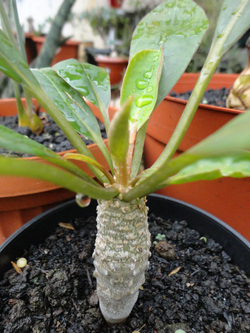
Found in Falaise de L'Ankarana, North-Western Madagascar, growing in black humus on limestone escarpment. It’s an unbranched stem specie, with silver white hairs on both side of the leaves. The flowers are greenish inside to rose outside with red margin.
IUCN Status: Endangered
IUCN Status: Endangered
Euphorbia brunellii
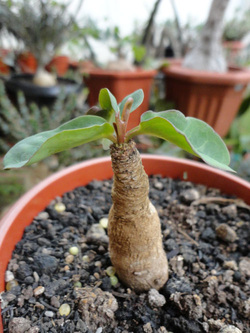
Described by Emilio Chiovenda in 1951. It is found in Ethiopia, Kenya, Sudan and Uganda, growing in a well drained soil with some water and some to lots of sun. The caudex can grow up to five centimetres in diameter, the plant can reach 25 centimetres.
Euphorbia bupleurifolia
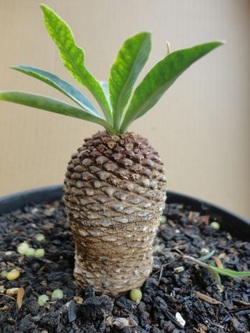
It is a handsome plant with tubercles on the stem and a crown of leaves on top, giving the plant the general appearance of a miniature cycad.
The South African Euphorbias with prominent leaves are rather more difficult to cultivate than some other Euphorbias , and Euphorbia bupleurifolia is no exception
Habitat: Eastern Cape and Kwazulu-Natal.
The South African Euphorbias with prominent leaves are rather more difficult to cultivate than some other Euphorbias , and Euphorbia bupleurifolia is no exception
Habitat: Eastern Cape and Kwazulu-Natal.
Euphorbia cylindrifolia ssp. tuberifera

A Madagascar euphorbia which described by Rauh 1963. When grown from seed, forms a conspicuous rounded tuber that can grow to fist-size or larger.
Habitat: in Alluaudia thorn forest between Amboasary and Fort Dauphin, Madagascar
IUCN Status: Endangered
Photo courtesy of Hendick Purwanto ([email protected])
Habitat: in Alluaudia thorn forest between Amboasary and Fort Dauphin, Madagascar
IUCN Status: Endangered
Photo courtesy of Hendick Purwanto ([email protected])
Euphobia francoisii
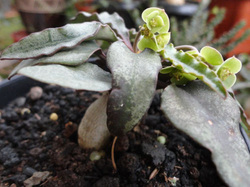
Described by Jacques Désiré Leandri in 1946. It is found in the Taolanaro Province, southern Madagascar, growing in a well drained soil with some water and some sun. The caudex can grow to three centimetres in diameter, the plant up to fifteen centimetres height. The flowers are greenish.
IUCN Status: Critically Endangered
IUCN Status: Critically Endangered
Euphorbia itremensis
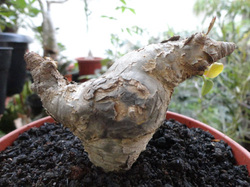
Described by Myron William Kimnach & John Jacob Lavranos in 2001.
It is found on Madagascar, growing in grit or other well drained soil with little to some water and lots of sun. The caudex can grow to twelve centimetres in diameter, the whole plant up to 20 or even 30 centimetres high. The flowers are white
IUCN Status: Vulnerable
It is found on Madagascar, growing in grit or other well drained soil with little to some water and lots of sun. The caudex can grow to twelve centimetres in diameter, the whole plant up to 20 or even 30 centimetres high. The flowers are white
IUCN Status: Vulnerable
Euphorbia millotti
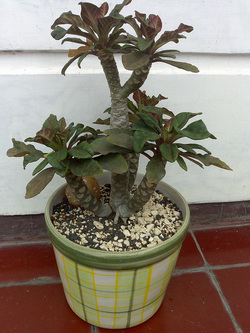
It is endemic to Madagascar. Its natural habitat is subtropical or tropical moist shrubland.
It has curly branches holding large flat green purple leaves.
IUCN Status: Critically Endangered
Photo courtesy of Hendick Purwanto ([email protected])
It has curly branches holding large flat green purple leaves.
IUCN Status: Critically Endangered
Photo courtesy of Hendick Purwanto ([email protected])
Euphorbia moratii
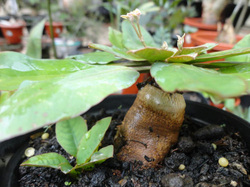
Described by Werner Rauh in 1970. It is found on Madagascar, growing in grit or other well drained soil with little water and lots of sun.
IUCN Status: Vulnerable
IUCN Status: Vulnerable
Euphorbia obesa
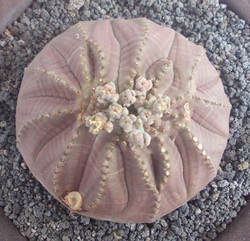
Euphorbia obesa is a peculiar, almost ball shaped dwarf succulent plant that resembles a stone. It can grow to 20 cm in height with a diameter of 9 cm. It is a single-stemmed, unbranched, firm-bodied plant. The stem is usually 8-angled and grooved, subglobose (almost spherical) in shape, elongating and becoming cylindric as it gets older. Younger plants have a rounded sea urchin-like shape. The rotund stem is mottled grey-green in colour with dull purple transverse bands. It has a tapering tap root. The leaves are very rudimentary and soon drop off. Euphorbia obesa is dioecious, i.e. male and female flowers occur on different plants
Euphorbia obesa is a rare endemic of the Great Karoo, south of Graaff-Reinet in the Eastern Cape.
Photo courtesy of Hendick Purwanto ([email protected])
Euphorbia obesa is a rare endemic of the Great Karoo, south of Graaff-Reinet in the Eastern Cape.
Photo courtesy of Hendick Purwanto ([email protected])
Euphorbia primuifolia
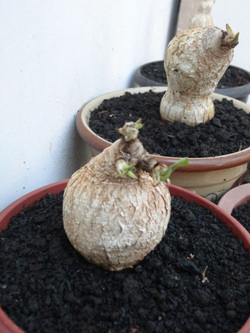
Described by John Gilbert Baker in
1880.
Growing in a well drained soil with some water and some sun. The caudex can grow to eight centimetres in diameter, the plant will grow to fifteen centimetres height. The flowers are white.
Habitat: Western and Central Madagascar
IUCN Status: Vulnerable
Growing in a well drained soil with some water and some sun. The caudex can grow to eight centimetres in diameter, the plant will grow to fifteen centimetres height. The flowers are white.
Habitat: Western and Central Madagascar
IUCN Status: Vulnerable
Euphorbia quartziticola
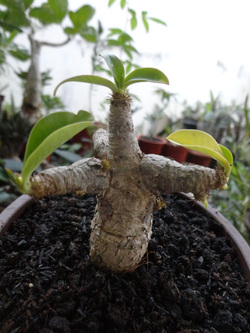
Described by Jacques Désiré Leandri in 1946.
It is found in 1500 meters height of the central plateau of Madagascar, growing in pure quarts sand. Needs some water and lots of sun. The swollen stems can grow up to nine centimetres in diameter, and reach a length of 30 centimetres. The flowers are yellow.
IUCN Status: Endangered
It is found in 1500 meters height of the central plateau of Madagascar, growing in pure quarts sand. Needs some water and lots of sun. The swollen stems can grow up to nine centimetres in diameter, and reach a length of 30 centimetres. The flowers are yellow.
IUCN Status: Endangered
Euphorbia silenifolia
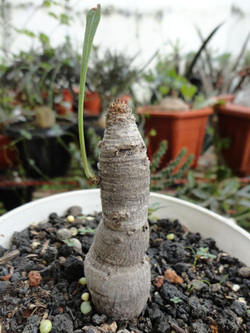
Given this name by Robert Sweet in 1830. It is found on the Cape, South Africa, growing in a well drained soil with some water and lots of sun. The caudex can grow to seven centimetres in diameter, the whole plant up to 20 centimetres height. The flowers are green.
Euphorbia squarrosa
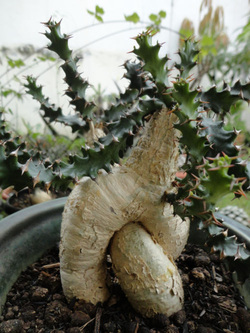
Described by Adrian Hardy Haworth in 1826. It is found on the eastern cape of South Africa, growing in a well drained soil with little to some water and lots of sun. The caudex can grow to ten centimetres in diameter, the whole plant up to 30 centimetres height. The flowers are greenish yellow.This rather various species may have 2 to 5 angled branches.
Euphorbia stellata
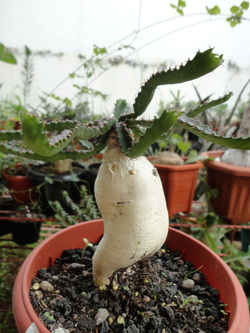
Described by Carl Ludwig von Willdenow in 1799. It is found on the Eastern Cape of South Africa, growing in a well drained soil with little to some water and some to lots of sun. The caudex can grow to seven centimetres in diameter, and will be buried in the wild. The branches can grow to fifteen centimetres length. The flowers are greenish yellow.
Euphorbia suzannae-marnierae
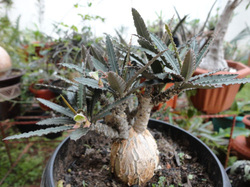
Described by Werner Rauh and Herman Pétignat in 1996. It is found on the southern tip of Madagascar, growing in well drained soil with some water and lots of sun.
Named after Mme Suzanna Marnier-Lapostolle, directrice of Jardin Botanique Les Cedres, France.
Named after Mme Suzanna Marnier-Lapostolle, directrice of Jardin Botanique Les Cedres, France.
Euphorbia waringiae
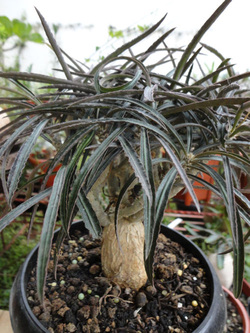
Described by Werner Rauh and Ratmond Gerold in 1998. Epithet named after Ratmond Gerold's wife's maiden name: Waring.
It is found in south-east Madagascar, growing in a well drained soil with little to some water and lots of sun. The caudex can grow to six centimetres in diameter, the whole plant reach 30 centimetres or more in height. The flowers are white to creme colour.
IUCN Status: Vulnerable
It is found in south-east Madagascar, growing in a well drained soil with little to some water and lots of sun. The caudex can grow to six centimetres in diameter, the whole plant reach 30 centimetres or more in height. The flowers are white to creme colour.
IUCN Status: Vulnerable
